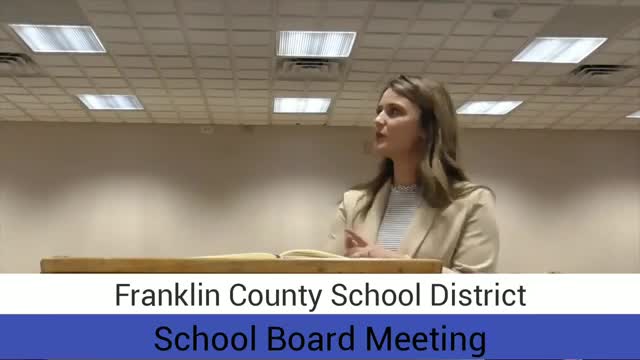District presents secondary academic snapshot: ACT changes, Exact Path growth and EOC gains at Franklin County High
March 11, 2025 | Franklin County, School Districts, Tennessee
This article was created by AI summarizing key points discussed. AI makes mistakes, so for full details and context, please refer to the video of the full meeting. Please report any errors so we can fix them. Report an error »

Rachel Shields, the district’s secondary supervisor, presented an overview of secondary programs, testing updates and recent student-performance data to the Franklin County Board of Education.
Shields said university partnerships are expanding: the district recommended two candidates to the UT Southern Grow Your Own apprenticeship program for the coming fall and expects two current participants to graduate this school year. She also reported the district received two student-teacher placements from Middle Tennessee State University for fall, including a library-media specialist and an elementary teacher.
Shields told the board that beginning this fall the science portion of the ACT will be optional for most students. "Starting in the fall, the science portion of ACT is going to be optional for students," she said, noting that students planning STEM majors might still opt to take it. Shields also said Franklin County High School will administer a free junior ACT the following day.
On outcomes, Shields compared recent state and district averages: the state composite ACT average was 19.3; Franklin County High School averaged 18 and Huntland averaged 19.4 for the 2024 graduating cohort. At the high-school level, Shields highlighted gains in end-of-course tests: algebra II proficiency rose from about 14.7% (fall 2023) to 24.2% (fall 2024); geometry rose from about 5% to 26%; English II increased from about 32.5% to 56.7%; biology also saw notable increases while U.S. history dropped slightly.
Shields described district supports for new teachers, including a mentor team of four teachers who host after-school learning sessions; she said the program has held three sessions this year with a fourth planned. She also discussed a collaboration of high-school math teachers convened after state data indicated low math scores, and said the district is trying to align supports between teachers and principals.
For middle grades, Shields presented Exact Path benchmark results and usage. She said the district started Exact Path in August; in sixth grade 71 students were on a “success path” (meeting or exceeding expectations on TCAP projections), seventh grade showed about 60 students projected proficient in math and ELA, and eighth grade figures were lower (about 36 projected for math, 34 for ELA). Shields cautioned the district lacks longitudinal proof that Exact Path correlates to TCAP outcomes because the program is new.
Shields repeatedly framed the data as a snapshot and emphasized district-level conversations with principals and teachers to support classroom instruction rather than placing sole responsibility on individual teachers.
Shields said university partnerships are expanding: the district recommended two candidates to the UT Southern Grow Your Own apprenticeship program for the coming fall and expects two current participants to graduate this school year. She also reported the district received two student-teacher placements from Middle Tennessee State University for fall, including a library-media specialist and an elementary teacher.
Shields told the board that beginning this fall the science portion of the ACT will be optional for most students. "Starting in the fall, the science portion of ACT is going to be optional for students," she said, noting that students planning STEM majors might still opt to take it. Shields also said Franklin County High School will administer a free junior ACT the following day.
On outcomes, Shields compared recent state and district averages: the state composite ACT average was 19.3; Franklin County High School averaged 18 and Huntland averaged 19.4 for the 2024 graduating cohort. At the high-school level, Shields highlighted gains in end-of-course tests: algebra II proficiency rose from about 14.7% (fall 2023) to 24.2% (fall 2024); geometry rose from about 5% to 26%; English II increased from about 32.5% to 56.7%; biology also saw notable increases while U.S. history dropped slightly.
Shields described district supports for new teachers, including a mentor team of four teachers who host after-school learning sessions; she said the program has held three sessions this year with a fourth planned. She also discussed a collaboration of high-school math teachers convened after state data indicated low math scores, and said the district is trying to align supports between teachers and principals.
For middle grades, Shields presented Exact Path benchmark results and usage. She said the district started Exact Path in August; in sixth grade 71 students were on a “success path” (meeting or exceeding expectations on TCAP projections), seventh grade showed about 60 students projected proficient in math and ELA, and eighth grade figures were lower (about 36 projected for math, 34 for ELA). Shields cautioned the district lacks longitudinal proof that Exact Path correlates to TCAP outcomes because the program is new.
Shields repeatedly framed the data as a snapshot and emphasized district-level conversations with principals and teachers to support classroom instruction rather than placing sole responsibility on individual teachers.
View full meeting
This article is based on a recent meeting—watch the full video and explore the complete transcript for deeper insights into the discussion.
View full meeting
